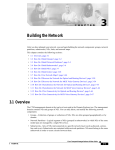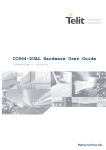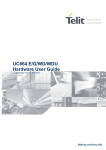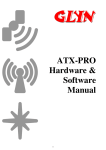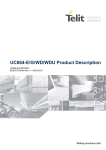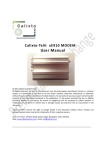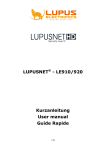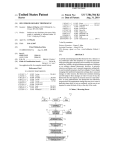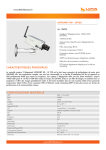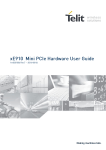Download QC Linux Driver User Guide
Transcript
QC Linux USB Driver - User Guide 1vv0300804 r7 04/11/2014 QC Linux USB Driver Software User Guide 1vv0300804 r7 04/11/2014 Disclaimer SPECIFICATIONS SUBJECT TO CHANGE WITHOUT NOTICE Notice While reasonable efforts have been made to assure the accuracy of this document, Telit assumes no liability resulting from any inaccuracies or omissions in this document, or from use of the information obtained herein. The information in this document has been carefully checked and is believed to be entirely reliable. However, no responsibility is assumed for inaccuracies or omissions. Telit reserves the right to make changes to any products described herein and reserves the right to revise this document and to make changes from time to time in content hereof with no obligation to notify any person of revisions or changes. Telit does not assume any liability arising out of the application or use of any product, software, or circuit described herein; neither does it convey license under its patent rights or the rights of others. It is possible that this publication may contain references to, or information about Telit products (machines and programs), programming, or services that are not announced in your country. Such references or information must not be construed to mean that Telit intends to announce such Telit products, programming, or services in your country. Copyrights This instruction manual and the Telit products described in this instruction manual may be, include or describe copyrighted Telit material, such as computer programs stored in semiconductor memories or other media. Laws in the Italy and other countries preserve for Telit and its licensors certain exclusive rights for copyrighted material, including the exclusive right to copy, reproduce in any form, distribute and make derivative works of the copyrighted material. Accordingly, any copyrighted material of Telit and its licensors contained herein or in the Telit products described in this instruction manual may not be copied, reproduced, distributed, merged or modified in any manner without the express written permission of Telit. Furthermore, the purchase of Telit products shall not be deemed to grant either directly or by implication, estoppel, or otherwise, any license under the copyrights, patents or patent applications of Telit, as arises by operation of law in the sale of a product. Computer Software Copyrights The Telit and 3rd Party supplied Software (SW) products described in this instruction manual may include copyrighted Telit and other 3rd Party supplied computer programs stored in semiconductor memories or other media. Laws in the Italy and other countries preserve for Telit and other 3rd Party supplied SW certain exclusive rights for copyrighted computer programs, including the exclusive right to copy or reproduce in any form the copyrighted computer program. Accordingly, any copyrighted Telit or other 3rd Party supplied SW computer programs contained in the Telit products described in this instruction manual may not be copied (reverse engineered) or reproduced in any manner without the express written permission of Telit or the 3rd Party SW supplier. Furthermore, the purchase Reproduction forbidden without Telit Communications S.p.A. written authorization - All Rights Reserved page 2 of 23 QC Linux USB Driver Software User Guide 1vv0300804 r7 04/11/2014 of Telit products shall not be deemed to grant either directly or by implication, estoppel, or otherwise, any license under the copyrights, patents or patent applications of Telit or other 3rd Party supplied SW, except for the normal non-exclusive, royalty free license to use that arises by operation of law in the sale of a product. Usage and Disclosure Restrictions License Agreements The software described in this document is the property of Telit and its licensors. It is furnished by express license agreement only and may be used only in accordance with the terms of such an agreement. Copyrighted Materials Software and documentation are copyrighted materials. Making unauthorized copies is prohibited by law. No part of the software or documentation may be reproduced, transmitted, transcribed, stored in a retrieval system, or translated into any language or computer language, in any form or by any means, without prior written permission of Telit High Risk Materials Components, units, or third-party products used in the product described herein are NOT fault-tolerant and are NOT designed, manufactured, or intended for use as on-line control equipment in the following hazardous environments requiring fail-safe controls: the operation of Nuclear Facilities, Aircraft Navigation or Aircraft Communication Systems, Air Traffic Control, Life Support, or Weapons Systems (High Risk Activities"). Telit and its supplier(s) specifically disclaim any expressed or implied warranty of fitness for such High Risk Activities. Trademarks TELIT and the Stylized T Logo are registered in Trademark Office. All other product or service names are the property of their respective owners. Copyright © Telit Communications S.p.A. 2014. Reproduction forbidden without Telit Communications S.p.A. written authorization - All Rights Reserved page 3 of 23 QC Linux USB Driver Software User Guide 1vv0300804 r7 04/11/2014 Applicable Products Product Supported UC864-E √ UC864-G √ UC864-WDU √ UC864-WD √ UC864-E-AUTO √ UC864-K √ CC864-DUAL √ CC864-SINGLE √ CC864-KPS √ DE910-DUAL √ CE910-DUAL √ LE920 √ LE910 √ HE920 √ UE910-V2 √ HE910-V2 √ Reproduction forbidden without Telit Communications S.p.A. written authorization - All Rights Reserved page 4 of 23 QC Linux USB Driver Software User Guide 1vv0300804 r7 04/11/2014 Contents 1 Introduction ...................................................................................................................................... 6 1.1 Scope ....................................................................................................................................................... 6 1.2 Audience ................................................................................................................................................. 6 1.3 Contact Information, Support .............................................................................................................. 6 1.4 Product Overview .................................................................................................................................. 7 1.5 Document Organization ........................................................................................................................ 7 1.6 Text Conventions ................................................................................................................................... 7 1.7 Related Documents ................................................................................................................................ 7 1.8 Document History .................................................................................................................................. 7 2 System Setup ..................................................................................................................................... 8 2.1 Linux USB Drivers Structure ............................................................................................................... 9 2.2 Loading the drivers ............................................................................................................................. 10 2.2.1 Loading the driver: option .............................................................................................................................. 10 2.2.2 Loading the driver: qmi_wwan ...................................................................................................................... 11 2.3 Building the drivers ............................................................................................................................. 12 2.3.1 Customizing the driver: option ....................................................................................................................... 12 2.3.1.1 Additional customization for LE910 and LE920 ............................................................................... 13 2.3.2 Customizing the driver: qmi_wwan ............................................................................................................... 13 2.3.3 Compiling the drivers ..................................................................................................................................... 14 3 Using the module ............................................................................................................................ 16 3.1 Using the driver: option ...................................................................................................................... 16 3.1.1 Shell commands ............................................................................................................................................. 16 3.1.2 Create a PPP connection ................................................................................................................................ 16 3.1.3 C programming .............................................................................................................................................. 18 3.1.3.1 open() ................................................................................................................................................. 18 3.1.3.2 read() .................................................................................................................................................. 19 3.1.3.3 write() ................................................................................................................................................. 19 3.1.3.4 close() ................................................................................................................................................. 20 3.1.3.5 Test Program ...................................................................................................................................... 21 3.2 Using the driver qmi_wwan ................................................................................................................ 22 Reproduction forbidden without Telit Communications S.p.A. written authorization - All Rights Reserved page 5 of 23 QC Linux USB Driver Software User Guide 1vv0300804 r7 04/11/2014 1 Introduction 1.1 Scope This user guide serves the following purpose: Provides details about Telit QC based modems Explains how to compile and install the Linux USB option and qmi_wwan drivers Describes how software developers can use the functions of Linux device drivers to configure, manage and use Telit modems 1.2 Audience This User Guide is intended for software developers who develop applications using Telit QC based modems and Linux. 1.3 Contact Information, Support Our aim is to make this guide as helpful as possible. Keep us informed of your comments and suggestions for improvements. For general contact, technical support, report documentation errors and to order manuals, contact Telit’s Technical Support Center at: [email protected] [email protected] [email protected] [email protected] Alternatively, use: http://www.telit.com/en/products/technical-support-center/contact.php Telit appreciates feedback from the users of our information. Reproduction forbidden without Telit Communications S.p.A. written authorization - All Rights Reserved page 6 of 23 QC Linux USB Driver Software User Guide 1vv0300804 r7 04/11/2014 1.4 Product Overview For modem features, please refer to the chosen modem user guide. 1.5 Document Organization This manual contains the following chapters: “Chapter 1, Introduction” provides a scope for this manual, target audience, technical contact information, and text conventions. “Chapter 2, System Setup” describes how to setup the system before using the USB driver. “Chapter 3, Using the module” details USB device driver use and shows how software developers can use it to interact with the modem through shell commands and C programming. How to Use If you are new to the chosen product, it is recommended to start by reading the related Hardware User Guide and Product Description in their entirety to better understand how the modem driver works. 1.6 Text Conventions This section lists the paragraph and font styles used for the various types of information presented in this user guide. Format Content Arial Linux shell commands, filesystem paths and example C source code 1.7 Related Documents All documentation can be downloaded from Telit official web site www.telit.com if not otherwise indicated. 1.8 Document History Revision ISSUE #0 ISSUE #1 ISSUE #2 ISSUE #3 Date Changes 2009-01-30 First Release 2010-01-13 Added CC864 Support Applied new layout 2012-02-13 Added DE910 Support New document organization 2012-06-12 Added CE910 Support Reproduction forbidden without Telit Communications S.p.A. written authorization - All Rights Reserved page 7 of 23 QC Linux USB Driver Software User Guide 1vv0300804 r7 04/11/2014 ISSUE #4 ISSUE #5 ISSUE #6 ISSUE #7 2013-02-20 Added LE920 and HE920 Support 2013-11-19 Added HE910-V2 and UE910-V2 Modified LE920 pid and interfaces 2014-10-27 Added LE910 and modified LE920 interfaces 2014-11-04 Added qmicli instructions for starting data connection with qmi Reproduction forbidden without Telit Communications S.p.A. written authorization - All Rights Reserved page 8 of 23 QC Linux USB Driver Software User Guide 1vv0300804 r7 04/11/2014 2 System Setup In the first part of this chapter the general organization of the USB stack in Linux is described. In the second part it is explained how to setup the system for using the module. Please note that all the instructions provided in this guide are generic: for further information refer to the documentation of your Linux distribution. 2.1 Linux USB Drivers Structure USB drivers lie between the different kernel subsystems (block, net, char, etc.) and the USB hardware controllers. The Linux USB core provides an interface for USB drivers to use and control the hardware, without having to worry about the different types of controllers that are present on the system. Reproduction forbidden without Telit Communications S.p.A. written authorization - All Rights Reserved page 9 of 23 QC Linux USB Driver Software User Guide 1vv0300804 r7 04/11/2014 The USB Core subsystem provides specific APIs to support USB devices and host controllers. Its purpose is to abstract all hardware or device dependent parts by defining a set of data structures, macros and functions. These functions can be grouped into an upper and a lower API layer: the upper layer APIs are used by device drivers, while the lower APIs are used by the host controllers. When a device driver or a host controller is loaded in Linux using the modprobe command, the USB core is also automatically loaded. 2.2 Loading the drivers 2.2.1 Loading the driver: option Linux OS includes a generic USB driver for GSM/CDMA modems in the form of a kernel module (called option): according to the considered kernel version it is possible that the driver should be customized for working well with Telit modules. Refer to chapter 2.3.1 for detailed instructions. Most recent Linux distributions do not require any user action in order to load this driver: it is enough to simply plug the USB cable. If the modem is recognized by the operating system some devices named /dev/ttyUSBx will be created. The number of devices varies according to the used module. For example the UC864-G presents the following devices: /dev/ttyUSB0 /dev/ttyUSB1 /dev/ttyUSB2 /dev/ttyUSB3 Please note that AT commands are allowed on Modem and Auxiliary ports. Refer to the following table for port setup details: UC864-E, UC864E-AUTO, UC864K, UC864-WD, UC864-WDU, CC864-SINGLE, CC864-KPS UC864-G, CC864DUAL, DE910-DUAL, HE920, HE910-V2 ttyUSB0 → Modem port ttyUSB1 → Diagnostic port ttyUSB2 → Auxiliary port ttyUSB0 → Modem port ttyUSB1 → Diagnostic port ttyUSB2 → NMEA port ttyUSB3 → Auxiliary port ttyUSB0 → Diagnostic port ttyUSB1 → NMEA port ttyUSB2 → Auxiliary port ttyUSB3 → Modem port Reproduction forbidden without Telit Communications S.p.A. written authorization - All Rights Reserved page 10 of 23 QC Linux USB Driver Software User Guide 1vv0300804 r7 04/11/2014 CE910-DUAL LE910, LE920 UE910-V2 ttyUSB0 → Diagnostic port ttyUSB1 → Modem port ttyUSB0 → Diagnostic port ttyUSB1 → NMEA port ttyUSB2 → Modem port 1 ttyUSB3 → Modem port 2 ttyUSB4→ SAP port ttyUSB0 → Diagnostic port ttyUSB1 → Auxiliary port ttyUSB2 → Modem port If no devices are created in your system check for the existence of the kernel module: # lsmod | grep option If no entries are found, load the kernel module, with root privileges: # modprobe option If an error response is returned, such as: # FATAL: Module option not found the meaning is that the kernel module is not present in your system and it should be built. Refer to the next chapter for generic instructions. 2.2.2 Loading the driver: qmi_wwan The LE910 and LE920 export also a network interface that can be used when the driver qmi_wwan is available (since the 3.4 version of the vanilla kernel). According to the considered kernel version it is possible that the driver should be customized for working well with Telit modules. Refer to chapter 2.3.2 for detailed instructions. If the driver is correctly loaded by the operating system a network interface named wwanx (e.g. wwan0) will be created. For checking the network interface presence, the ifconfig command can be used: ifconfig –a If no network interface is created in your system check for the existence of the kernel module: # lsmod | grep qmi_wwan If no entry is found, load the kernel module, with root privileges: Reproduction forbidden without Telit Communications S.p.A. written authorization - All Rights Reserved page 11 of 23 QC Linux USB Driver Software User Guide 1vv0300804 r7 04/11/2014 # modprobe qmi_wwan If an error response is returned, such as: # FATAL: Module qmi_wwan not found the meaning is that the kernel module is not present in your system and it should be built. Refer to the next chapter for generic instructions. 2.3 Building the drivers 2.3.1 Customizing the driver: option If the modem is not recognized by the system it is possible that the driver should be customized for working correctly with Telit modules. Retrieve the appropriate kernel source code version for your system (preferably with the distribution package system, if any) and unpack/install it. From the unpacking root directory open the file: /drivers/usb/serial/option.c Check for the existence of the proper #define statement related to your module, according to the following table: UC864-E, UC864E-AUTO, UC864K, UC864-WD, UC864-WDU UC864-G CC864-DUAL CC864-SINGLE, CC864-KPS CC864-K DE910-DUAL, HE920, HE910-V2 CE910-DUAL LE910, LE920 UE910-V2 #define TELIT_PRODUCT_UC864E 0x1003 #define TELIT_PRODUCT_UC864G #define TELIT_PRODUCT_CC864_DUAL #define TELIT_PRODUCT_CC864_SINGLE 0x1004 0x1005 0x1006 #define TELIT_PRODUCT_DE910_DUAL 0x1010 #define TELIT_PRODUCT_CE910_DUAL #define TELIT_PRODUCT_LE920 #define TELIT_PRODUCT_UE910_V2 0x1011 0x1201 0x1012 If not present, add the statement. Reproduction forbidden without Telit Communications S.p.A. written authorization - All Rights Reserved page 12 of 23 QC Linux USB Driver Software User Guide 1vv0300804 r7 04/11/2014 Then add the proper line in the usb_device_id option_ids[] structure:, according to the following table: UC864-E, UC864E-AUTO, UC864K, UC864-WD, UC864-WDU UC864-G CC864-DUAL CC864-SINGLE, CC864-KPS DE910-DUAL, HE920, HE910-V2 CE910-DUAL UE910-V2 { USB_DEVICE(TELIT_VENDOR_ID, TELIT_PRODUCT_UC864E) }, { USB_DEVICE(TELIT_VENDOR_ID, TELIT_PRODUCT_UC864G) }, { USB_DEVICE(TELIT_VENDOR_ID, TELIT_PRODUCT_CC864_DUAL) }, { USB_DEVICE(TELIT_VENDOR_ID, TELIT_PRODUCT_CC864_SINGLE) }, { USB_DEVICE(TELIT_VENDOR_ID, TELIT_PRODUCT_DE910_DUAL) }, { USB_DEVICE(TELIT_VENDOR_ID, TELIT_PRODUCT_CE910_DUAL) }, { USB_DEVICE(TELIT_VENDOR_ID, TELIT_PRODUCT_UE910_V2) }, Save the changes and close the file. 2.3.1.1 Additional customization for LE910 and LE920 The LE910 and LE920 have the same USB interfaces configuration. They require specific customization for not letting the driver option claim other USB interfaces needed by different drivers. The driver option should not be bound to the interfaces 1 and 2. According to the kernel version, different changes should be done in the option source code. As an example we can consider the source code of the 3.7 kernel version. First, add the following struct: static const struct option_blacklist_info telit_le920_blacklist = { .reserved = BIT(1) | BIT(2), }; Then, the following line should be added to the usb_device_id option_ids[] structure: { USB_DEVICE(TELIT_VENDOR_ID, TELIT_PRODUCT_LE920), .driver_info = (kernel_ulong_t)&telit_le920_blacklist }, 2.3.2 Customizing the driver: qmi_wwan When using LE910 or LE920, if the network interface is not recognized by the system it is possible that the driver should be customized. Retrieve the appropriate kernel source code version for your system (preferably with the distribution package system, if any) and unpack/install it. From the unpacking root directory open the file: Reproduction forbidden without Telit Communications S.p.A. written authorization - All Rights Reserved page 13 of 23 QC Linux USB Driver Software User Guide 1vv0300804 r7 04/11/2014 /drivers/net/usb/qmi_wwan.c LE920 VID, PID and interface info should be added to the driver source code. According to the kernel version, different changes should be done in the source code. As an example we can consider the source code of the 3.7 kernel version. The following line should be added to the usb_device_id products[] structure: {QMI_FIXED_INTF(0x1bc7, 0x1201, 2)}, /* Telit LE920 */ 2.3.3 Compiling the drivers From the unpacking root directory of your kernel run the kernel configuration system (e.g. menuconfig). Configure the kernel according to the considered system configuration; then browse through the menus “Device Drivers” → “USB Support” → “USB Serial Converter support” and choose to build “USB driver for GSM and CDMA modems” as a module: When using the LE920 browse through the menus “Device Drivers” → “Network Device Support” → “USB Network Adapters” and choose to build “QMI WWAN driver for Qualcomm MSM based 3G and LTE modems” as a module. Once configured, start the build. The kernel module option.ko can be found in the directory drivers/usb/serial, while the module qmi_wwan.ko can be found in the directory drivers/net/usb. If the kernel has been previously already built, the module can be compiled simply typing: # make M=drivers/usb/serial Reproduction forbidden without Telit Communications S.p.A. written authorization - All Rights Reserved page 14 of 23 QC Linux USB Driver Software User Guide 1vv0300804 r7 04/11/2014 for option or # make M=drivers/net/usb for qmi_wwan. The modules can then be loaded using modprobe or insmod. In order to avoid runtime loading, the drivers should not be built as a modules, but as parts of the kernel. This is the suggested configuration for Android devices. Reproduction forbidden without Telit Communications S.p.A. written authorization - All Rights Reserved page 15 of 23 QC Linux USB Driver Software User Guide 1vv0300804 r7 04/11/2014 3 Using the module 3.1 Using the driver: option 3.1.1 Shell commands For testing the serial ports created by the driver, type in a shell (replace the name of the device with the proper one): # cat /dev/ttyUSBx & # echo –en "ATE0\r" > /dev/ttyUSBx1 # echo –en "AT\r" > /dev/ttyUSBx in order to print on standard output the answer of the modem to the command “ATE0\r” and “AT\r”. Please note that sending the command “ATE0” is mandatory, otherwise there could be issues in the terminal output. 3.1.2 Create a PPP connection Most recent Linux distributions have GUI tools for creating PPP connections; the following instructions are for creating a PPP connection through command line interface. PPP support needs to be compiled into the kernel; pppd and chat programs are also needed. pppd needs two scripts: the first script performs the environment setting and calls the second script, used by the chat program. For creating a PPP connection type: # pppd file /etc/pppd_script & The use of “ATE0” (echo disabled) before any other AT command is necessary because it prevents the sending/receiving of spurious characters to/from the modem when used in interaction with the Linux commands “echo” and “cat”. 1 Reproduction forbidden without Telit Communications S.p.A. written authorization - All Rights Reserved page 16 of 23 QC Linux USB Driver Software User Guide 1vv0300804 r7 04/11/2014 Example of pppd_script : # Debug info from pppd debug #kdebug 4 # Most phones don't reply to LCP echos lcp-echo-failure 3 lcp-echo-interval 3 # Keep pppd attached to the terminal # Comment this to get daemon mode pppd nodetach # The chat script (be sure to edit that file, too!) connect "/usr/sbin/chat -v -f /etc/chatscripts/hsdpa_connect" # Serial Device to which the phone is connected /dev/ttyUSBx # Serial port line speed 115200 dump # The phone is not required to authenticate #noauth user <insert here the correct username for authentication> name <insert here the name of the connection> password <insert here the correct password for authentication> # If you want to use the HSDPA link as your gateway defaultroute # pppd must not propose any IP address to the peer #noipdefault ipcp-accept-local ipcp-accept-remote # Keep modem up even if connection fails #persist # Hardware flow control crtscts # Ask the peer for up to 2 DNS server addresses usepeerdns # No ppp compression novj nobsdcomp novjccomp nopcomp noaccomp # For sanity, keep a lock on the serial line lock # Show password in debug messages show-password Reproduction forbidden without Telit Communications S.p.A. written authorization - All Rights Reserved page 17 of 23 QC Linux USB Driver Software User Guide 1vv0300804 r7 04/11/2014 This script calls the option “connect” using the script “hsdpa_connect”; following there is an example of this script: #!/bin/sh # Connection to the network '' AT+CGDCONT=1,"IP","<insert here the correct APN provided by your network operator>" # Dial the number. OK ATD*99***1# # The modem is waiting for the following answer CONNECT '' After launching a PPP connection is possible to use ftp protocol or other utilities that allow the access to the Internet. 3.1.3 C programming The following paragraphs show all the functions that can be used from C source code to perform read/write operations on the serial devices. 3.1.3.1 open() The open() function shall establish the connection between a file and a file descriptor. The file descriptor is used by other I/O functions to refer to that file. Header file: fcntl.h Prototype: int open(const char *pathname, int flags) Parameters: pathname – file name with its own path flags – is an int specifying file opening mode: is one of O_RDONLY, O_WRONLY or O_RDWR which request opening the file read-only, write-only or read/write, respectively Returns: The new file descriptor fildes if successfull, -1 otherwise Example: Open the /dev/ttyUSBx. int fd; // file descriptor for the /dev/ttyUSBx entry if((fd = open("/dev/ttyUSBx", O_RDONLY) < 0) { Reproduction forbidden without Telit Communications S.p.A. written authorization - All Rights Reserved page 18 of 23 QC Linux USB Driver Software User Guide 1vv0300804 r7 04/11/2014 /* Error Management Routine */ } else { /* ttyUSBx Device Opened */ } 3.1.3.2 read() The read() function reads nbyte bytes from the file associated with the open file descriptor, fildes, and copies them in the buffer that is pointed to by buf. Header file: unistd.h Prototype: ssize_t read(int fildes, void *buf, size_t nbyte) Parameters: fildes – file descriptor buf – destination buffer pointer nbyte – number of bytes that read() attempts to read Returns: The number of bytes actually read if the operation is completed successfully, otherwise it is -1. Example: Read sizeof(read_buff) bytes from the file associated with fd and stores them into read_buff. char read_buff[BUFF_LEN]; if(read(fd, read_buff, sizeof(read_buff)) < 0) { /* Error Management Routine */ } else { /* Value Read */ } 3.1.3.3 write() The write() function writes nbyte bytes from the buffer that are pointed by buf to the file associated with the open file descriptor, fildes. Header file: unistd.h Reproduction forbidden without Telit Communications S.p.A. written authorization - All Rights Reserved page 19 of 23 QC Linux USB Driver Software User Guide 1vv0300804 r7 04/11/2014 Prototype: ssize_t write(int fildes, const void *buf, size_t nbyte) Parameters: fildes – file descriptor buf – destination buffer pointer nbyte – number of bytes that write() attempts to write Returns: The number of bytes actually written if operation is completed successfully (this number shall never be greater than nbyte), otherwise it is -1. Example: Write strlen(value_to_be_written) bytes from the buffer pointed by value_to_be_written to the file associated with the open file descriptor, fd. char value_to_be_written[] = “dummy_write”; if (write(fd, value_to_be_written, strlen(value_to_be_written)) < 0) { /* Error Management Routine */ } else { /* Value Written */ } 3.1.3.4 close() The close() function shall deallocate the file descriptor indicated by fildes. To deallocate means to make the file descriptor available for return by subsequent calls to open() or other functions that allocate file descriptors. Header file: unistd.h Prototype: int close(int fildes); Parameters: fildes – file descriptor Returns: 0 if successfull, -1 otherwise Example: Close the ttyUSBx file. Reproduction forbidden without Telit Communications S.p.A. written authorization - All Rights Reserved page 20 of 23 QC Linux USB Driver Software User Guide 1vv0300804 r7 04/11/2014 if(close(fd) < 0) { /* Error Management Routine */ } else { /* File Closed */ } 3.1.3.5 Test Program The following simple C program is useful to test the modem issuing an AT command. The program opens the /dev/ttyUSBx device and calls the write() and the read() function to send an AT command and receive the subsequent output. #include <stdio.h> /* Standard input/output definitions */ #include <string.h> /* String function definitions */ #include <unistd.h> /* UNIX standard function definitions */ #include <fcntl.h> /* File control definitions */ #include <errno.h> /* Error number definitions */ #include <termios.h> /* POSIX terminal control definitions */ #define USB #define BUFSIZE #define BAUDRATE "/dev/ttyUSBx" 1000 B115200 int open_port(char *port) { struct termios options; int fd; fd = open(port, O_RDWR | O_NOCTTY | O_NDELAY); if (fd == -1) { printf("open_port: Unable to open the port - "); } else { printf ( "Port %s with file descriptor=%i",port, fd); fcntl(fd, F_SETFL, FNDELAY); tcgetattr( fd, &options ); cfsetispeed( &options, BAUDRATE ); cfsetospeed( &options, BAUDRATE ); options.c_cflag |= ( CLOCAL | CREAD); Reproduction forbidden without Telit Communications S.p.A. written authorization - All Rights Reserved page 21 of 23 QC Linux USB Driver Software User Guide 1vv0300804 r7 04/11/2014 options.c_cflag &= ~(CSIZE | PARENB | CSTOPB | CSIZE); options.c_cflag |= CS8; options.c_cflag &= ~CRTSCTS; options.c_lflag &= ~(ICANON | ECHO | ECHOE | ISIG); options.c_iflag &= ~(IXON | IXOFF | IXANY | ICRNL | INLCR | IGNCR); options.c_oflag &= ~OPOST; if ( tcsetattr( fd, TCSANOW, &options ) == -1 ) printf ("Error with tcsetattr = %s\n", strerror ( errno ) ); else printf ( "%s\n", "succeed" ); } return (fd); } int main() { int serialFD = open_port(USB); char buf[BUFSIZE]; memset(buf,0,BUFSIZE); write(serialFD, "AT\r" , strlen("AT\r")); sleep(1); read( serialFD, buf, BUFSIZE ); printf("The string is: %s\n", buf); close(serialFD); return 0; } The “sleep” instruction is necessary because the response of the modem after issuing the command “AT” is not immediate, so you need to wait a bit before reading. Obviously there are more efficient ways to do this, that is, for example, put the “read” call in a while loop and exit when the read buffer contains a certain string. 3.2 Using the driver qmi_wwan To use the network interface exported by LE910 and LE920 a modem manager with support for QMI is recommended. The libqmi project (cgit.freedesktop.org/libqmi) is an open-source QMI modem protocol helper library. It can be used for starting the data connection on the network interface of the modem with the following steps: Reproduction forbidden without Telit Communications S.p.A. written authorization - All Rights Reserved page 22 of 23 QC Linux USB Driver Software User Guide 1vv0300804 r7 04/11/2014 - Through /dev/ttyUSBx send the following AT command: AT+CGDCONT=1,”IPV4V6”,”<apn name>” - From a root shell type: ifconfig wwan0 up qmicli -d /dev/cdc-wdm0 --wds-start-network= --client-no-release-cid dhclient wwan0 - Check if the network interface has a valid ip address: ifconfig wwan0 qmicli is a command line tool available in the libqmi package. Please note that this is only an example of usage. The suggested commands can be different depending on the libqmi version and the system used. For detailed instructions and further documentation please refer to the project website. Reproduction forbidden without Telit Communications S.p.A. written authorization - All Rights Reserved page 23 of 23

























